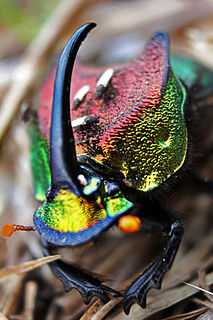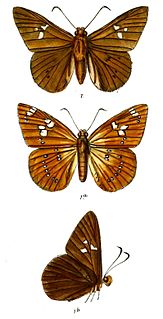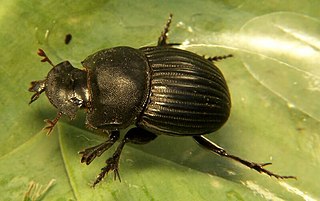
Phanaeus vindex, the rainbow scarab or rainbow scarab beetle is a North American dung beetle, with a range from the eastern US to the Rocky Mountains. The head is a metallic yellow color, and males have a black horn which curves backward toward the thorax. Both sexes have yellow antennae which can retract into a ball on the underside of the head. The thorax is a shiny coppery color, with yellow or green on the sides. The abdomen is metallic green. The underbelly is black and green. Body length is about 2–3 cm (0.8-1.2 in) long.

The scarab beetle subfamily Scarabaeinae consists of species collectively called true dung beetles. Most of the beetles of this subfamily feed exclusively on dung. However, some may feed on decomposing matter including carrion, decaying fruits and fungi. Dung beetles can be placed into three structural guilds based on their method of dung processing namely rollers, dwellers and tunnelers Dung removal and burial by dung beetles result in ecological benefits such as soil aeration and fertilization; improved nutrient cycling and uptake by plants, increase in Pasture quality, biological control of pest flies and intestinal parasites and secondary seed dispersal. Well-known members include the genera Scarabaeus and Sisyphus, and Phanaeus vindex.

Capila phanaeus, the fulvous dawnfly, is a species of hesperid butterfly found in India and Southeast Asia.
Vindex is a Roman governor of Gaul.

Phanaeus splendidulus is a species of beetles belonging to the family Scarabaeidae.

Phanaeus demon is a species of beetles belonging to the family Scarabaeidae. This species is often incorrectly named as "damon" in collections and in the literature.

Phanaeus difformis is a species of dung beetles in the family Scarabaeidae.
Melanocanthon nigricornis is a species of dung beetle in the family Scarabaeidae.

Melanocanthon is a genus of dung beetles in the family Scarabaeidae. There are at least 4 described species in Melanocanthon.

Copris fricator is a species of dung beetle in the family Scarabaeidae.
Phanaeus dionysius is a species of dung beetle in the family Scarabaeidae. It is found in region of San Pablo Etla of Oaxaca, Mexico.

Phanaeus igneus is a species of dung beetle in the family Scarabaeidae.

Phanaeus quadridens is a species of dung beetle in the family Scarabaeidae.
Phanaeus triangularis is a species of dung beetle in the family Scarabaeidae.

The Cangahua Formation is a Late Pleistocene geologic formation of the Pichincha Province in north-central Ecuador.














